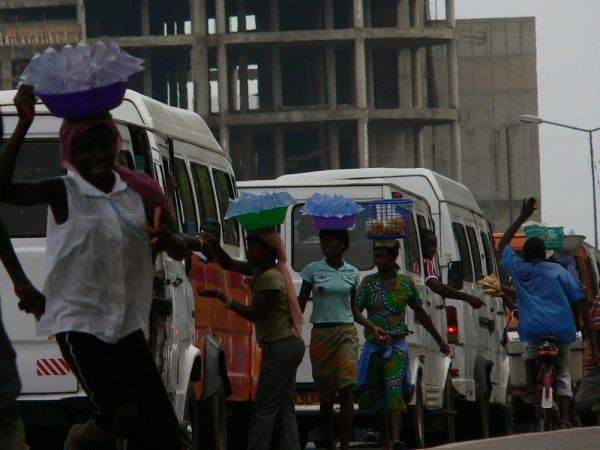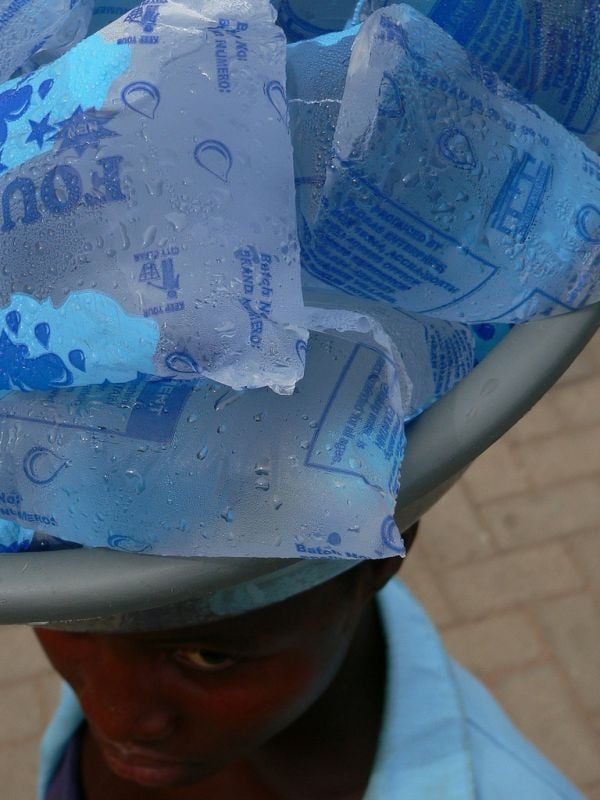Tiny Bags of Water Buoy an Economy, and Make a Big Mess

Pure water is everywhere in Accra, providing cheap, relatively safe drinking water to the masses. Photo credit: Jake Brown
“PURE-water!”
It’s a refrain often heard around Accra, accompanied most often by the appearance of a sweating woman or girl with a pan on her head filled with cold plastic sachets of water. A “pure water” seller and her familiar cry will always be cutting through the throngs of hawkers surrounding stalled traffic or haunting busy markets.
Pure water is the common name for the little plastic sachets of drinking water that have been part of my experience of Accra since the day I arrived. Five hundred milliliters of water packaged neatly in a plastic sleeve and stamped with the approval of the Ghana Standards Authority, sachet water is everywhere. Women hawk it in traffic. People sell it in coolers on the side of the street. Roadside shops sell sachets individually from refrigerators or wholesale in bags of thirty. Flatbed trucks and three-wheeled carts loaded with bags of sachet water are common sights on the motorways. And their skeletons are everywhere, too: Empty water sachets litter the roadsides and the gutters, clogging drains and making their way to the ocean.
So ubiquitous is pure water in Accra that it wasn’t until I spoke with Justin Stoler, a University of Miami researcher who studies sachet water, that I realized how recent a phenomenon it is, and how significant. The rise of sachet water has created a huge urban economy, its very own black market, an environmental disaster and a private-sector-driven public health coup.
Only two water treatment plants supply the entire city, and the Accra Metropolitan Authority has not been able to install new water connections nearly fast enough to keep up with rapid population growth. The Ghana Water Company, Ltd. can only produce enough water at any given time to fill about half of Accra’s pipe network, according to Stoler’s research.
So the public has turned to the private sector for their water. As recently as the mid 1990s, vendors sold drinking water by the cup or in plastic bags that were tied up individually at the point of sale. In the late ’90s, though, a small innovation changed everything: Someone started filling plastic sleeves of treated water and heat-sealing them, creating water-to-go on demand.
The low cost of production meant the sachets could be sold cheaply. When sachet water was first manufactured, it generally sold for roughly three cents per sachet. (Now the standard price is five cents.) Suddenly Accra had easy, cheap access to drinking water that was perceived as better than the municipal supply.
Quickly, Stoler says, the industry exploded. The big bottled water companies started manufacturing sachet water, and a cottage industry grew up around sachet water production. Individuals and small companies started packaging water, most of which was simply siphoned out of regular taps. And a supply chain grew around it: Truck and cart drivers distribute the water to every corner of the city. The “job” of the informal pure-water street vendor was born.
Rita Ama Amayabeia, 25, is a mother of three young children and a street vendor who sells sachet water. She works around Shiashie Junction, where nearly fifty other vendors weave through the four (or five or six) lanes of traffic that build up while waiting to turn left onto Liberation Avenue. Rita makes around seven to ten cedis ($3.50 to $5 USD) a day on pure water sales, earning a profit of one cedi per thirty-pack.

The water sachet industry has created its own economy and revolutionized the way water is consumed. Photo credit: Jake Brown
Profits from sachet water, though, are highly seasonal. Faustina Aklogo, 22, moved to Accra from her home in the Upper East Region of Ghana a year ago after completing secondary school. She sells mobile phone credit and sachet water out of a cooler and on a corner near Accra Mall, hoping to save enough money to pay for teacher training college. “First I was selling only credit,” she says, “and then [my customers] started asking of pure water so I decided to bring some.” Now that she does sell sachet water, during the dry season she’ll sell eight or nine packs of thirty. In the rainy season, however, when water is not so scarce, she’ll sell less than two packs a day.
Though I was wary of drinking water from a plastic bag when I first encountered it, at five cents a sachet, pure water quickly became my own go-to beverage as well. Bottled water is twenty to thirty times as expensive, making pure water an obvious choice for the poor, who often have little access to municipal water, which has its own spotty reputation. I also learned to trust Ghanaians’ evaluations of sachet water as being (mostly) safe to drink. Their opinions, it turns out, are another important part of the story of pure water.
Rita only sells the Standard brand of sachet water, and Faustina only sells Ice Pak. These are two of the handful of brands that consumers typically identify as high quality. “There is brand perception,” Stoler says. “Customers are becoming a little more brand savvy.” Five years ago, he says, that kind of consumer distinction didn’t exist. “There has been a natural sorting that corporations have benefitted from.”
Stoler is referring to the controversies that have sprung up over the years around the quality of sachet water. In the early years of the sachet water industry, thousands of brands were created. “Everybody was making so much money that there was a boom,” Stoler says. Many of these brands – possibly half or more – operated without registering with the Ghana Standards Board. Stoler describes people playing cat-and-mouse with the authorities, packaging water in super-cheap plastics out of shacks, and picking up and moving on if they were discovered by regulators.
Then, researchers such as Dr. K.K. Addo at the University of Ghana found that significant percentages of sachet water sampled were contaminated with fecal bacterial and E. coli. But over the last few years, registration and regulation have been catching up, Stoler says, and consumers have become more discriminating in what they’ll buy.
If you ask the average person on the street, they’ll tell you four or five brands of sachet water that they consider safe and high quality. These are generally the few large-scale producers, which raises the question of whether the good reputation of these brands is based on merit or just marketing. Stoler decided to test different brands and compare the results with public perception. He found that brands with a positive reputation were 90 percent less likely to have bacteriological contamination. “This is an evolving industry,” says Stoler. “Maybe in another three to five years we’ll see sachets reaching the homogeneity of product quality that you see with bottled water.”
Furthermore, despite alarm about quality, there are enormous public health benefits to sachet water consumption. Using sachet water as a household’s primary drinking water source, another of Stoler’s studies found, “had a protective effect against diarrhea episodes” in young children. Many people have figured this out. As of 2010, nearly a third of households in Accra were using sachet water as their primary drinking water source.
But sachet water has one deeply problematic side effect. As of 2004, 270 tons of plastic waste were generated each day in Accra, mostly from sachet water and ice cream packaging. This could be several orders of magnitude higher now, as consumption has grown significantly. These plastics choke drains, causing flooding and outbreaks, ironically, of waterborne diseases. They also cause untold environmental damage as they litter streams and pour into the ocean. Stepping into the water at a beach around Accra almost always results in entanglements with the little plastic bags bobbing in the waves.
Every year, a ban on plastic bags, which would include the sachets, is floated. But the consequences of such a move could be severe. “Water access for a significant number of urban poor would be severely marginalized if the government banned sachets as part of a larger ban on plastic bags,” writes Stoler and his colleagues in one study.
Recycling proposals have gained almost no traction, and the efforts of some small NGOs like Trashy Bags to create a market for recycled sachet products have had little effect thus far. Biodegradable sachets may be the best hope for an environmentally friendly sachet water product, but they’re still too expensive to be adopted by producers voluntarily. Innovation in plastics could go a long way to solve the environmental damage wreaked by the sachet water industry.
Despite its problems, Ghana’s sachet water industry is far of ahead of its neighbors. In Nigeria, for example, “people are filling sachets with river water,” Stoler says. “Ghana has done a better job. The bigger players looked and saw it was a product that was here to stay.”









